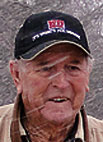
Seniors Clarence and La Joyce Duncan met at a church potluck in 2005 and built a home together before they married in 2007. For La Joyce the home was a fulfillment of a lifetime dream. She had always wanted a home on the family homestead and land which has been in their possession for 68 years. The couple has 220 acres on Heflin-Thomas Farm outside of West Fork, Ark., and runs a 56 head herd of Charolais with 26 mommas and one bull. Though some are registered and all could be, the couple feels that registration is an unnecessary expense for them at this time.
The choice of Charolais came along with Clarence because Clarence already had a small herd. Clarence’s father was an early club breeder of Charolais because 50 years ago he believed the new breed could be highly successful. Clarence began by buying a few from his father, adding a few others and using both embryo transplant and AI. In his opinion, the breed has become stronger in the last 25 years. The advantages are they birth easily, produce good quantities of milk and have good-sized calves that outgrow black calves. Charolais are also heat resistant, grow well on grass and can sometimes produce calves for 18 to 20 years. All of this translates into a good crossbreeding animal. Clarence said, “In order to get the best qualities in a commercial herd, crossbreeding is the answer, and the purpose of our herd is to sell breeding stock.” Clarence always did his own AI but at 86 years old admits to losing the precise feeling in his left hand to do it by himself anymore.
One serious problem in the cattle industry is Trichomoniasis (Trich), which is a highly contagious venereal disease. The Duncans have a closed herd which means they do not buy animals elsewhere and keep their animals isolated from all other cattle. The result is that their herd is Trich free, something absolutely essential in breeding stock. Clarence said, “We are proud of our animals and the lifetime of breeding and care that have produced a reputation that matches the quality of our herd.”
Their relatively recent marriage and partnership has not been problem free. One of their objectives is to have a fully developed rotational grazing system with at least 8 to 10 pastures. The project requires carefully designed pastures with each having its own water source as well as regulation fencing.
Last year while the couple was hurrying to finish fencing a new pasture by a December 31 deadline, Clarence had a major heart attack. The fencing had to be done very quickly, and the couple could obviously not complete the task in time. The Alpha Gamma Rho fraternity at the University of Arkansas came to the rescue. One of the members was the son of a longtime family friend and he brought 20 others with him. The young men were divided into teams of four with each one headed by someone who knew how to fence. The posts were already in, and La Joyce had everything carefully organized. They fenced more than 1,000 feet over rough terrain in one day with a huge country meal waiting for them at the end of the day. La Joyce said, “We never would have met the deadline without the help of those boys and we are forever grateful. They still call once in a while and come out to help with whatever needs to be done. There are no finer young men.”
The couple has other innovations in mind as well. They plan on sowing 10 acres of field in turnips as a dietary supplement. Last year they also tried sea salt mineral meal as a fertilizer and sprayed a test pasture. The sprayed pasture was a deeper, richer green and did better in the drought. Clarence believes commercial fertilizer prices are going to skyrocket making sea salt fertilizer even more desirable.
Clarence and La Joyce are civically active and try to promote agriculture every day. They are members of the Arkansas Cattlemen’s Board and Farm Bureau Board, and La Joyce works with leadership training for older children.







